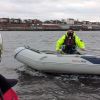Quote:
Originally Posted by catabisis

I certainly do want them, if it makes boating safer. I will look into it. However, I don't think I will be banging away on rough days. Not on Lake Erie anyway.
|
They are an extremely effective way of emptying a boat quickly. It doesn't need to be that rough to stuff* a small inflatable, and even on a flat day you can poop** it easily. You will commonly see them referred to here as elephants trunks because they are often grey floppy tubes! On boats with a centre console people who use them regularly will bring the thin rope forward to the helm position so they can be deployed / retrieved without leaving your seat. Others will generally leave the trunks down when underway "just in case". One advantage of trunks is that with a "dry" boat the trunk collapses on itself making the rate of water leaking back into the boat quite low if you stop for a short period. On a tiller steered SIB they are "to hand" though so most people would probably deploy (i.e. let flop down) as and when needed. Most SIBS would be fine with just one - but this boat is ex RNLI.
My 4m boat doesn't have trunks - but does have a big bung in the back which does a similar job. Boat fills with water - then move fast and remove bung which sucks the water out the back, refit bung before stopping. A trunk would be better, but are not widely fitted on small boats as standard.
Quote:
|
I like the way you have the compartments in the fore on the tubes. It is another thing I will look into to doing. Where did you get them?
|
The pouches will be original RNLI fittings. Any good tube maker/repairer should be able to make/fit something.
* Stuff is a term used to describe driving a boat "under" a wave rather than "over it". If you do it "right" the front disappears under the water momentarily and green water rolls over the front, though the boat. Its not the same as spray from bursting "through" a wave.
** Poop is a term used to describe water coming over the back of the transom when e.g. you stop quickly and your stern wave catches back up with you - a similar effect can be found when driving hard in reverse.



















